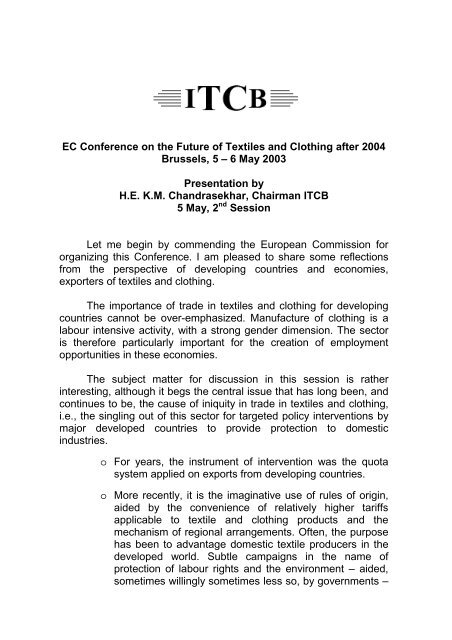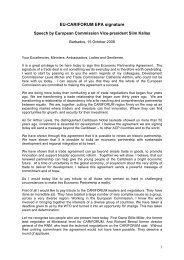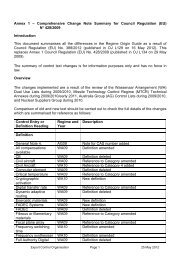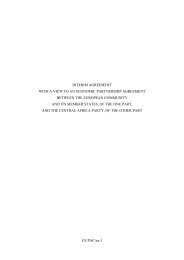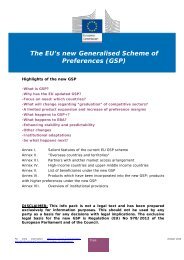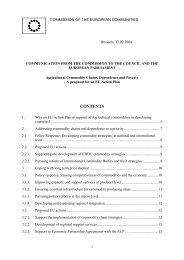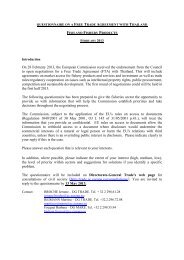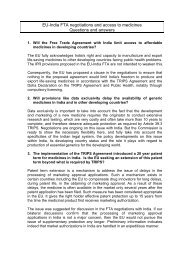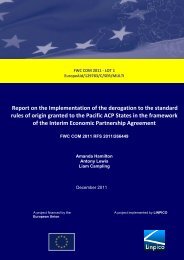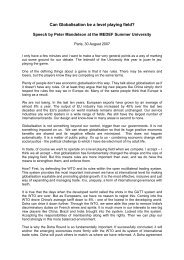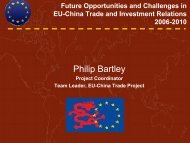EC Conference on the Future of Textiles and Clothing after 2004
EC Conference on the Future of Textiles and Clothing after 2004
EC Conference on the Future of Textiles and Clothing after 2004
You also want an ePaper? Increase the reach of your titles
YUMPU automatically turns print PDFs into web optimized ePapers that Google loves.
<str<strong>on</strong>g>EC</str<strong>on</strong>g> <str<strong>on</strong>g>C<strong>on</strong>ference</str<strong>on</strong>g> <strong>on</strong> <strong>the</strong> <strong>Future</strong> <strong>of</strong> <strong>Textiles</strong> <strong>and</strong> <strong>Clothing</strong> <strong>after</strong> <strong>2004</strong><br />
Brussels, 5 – 6 May 2003<br />
Presentati<strong>on</strong> by<br />
H.E. K.M. Ch<strong>and</strong>rasekhar, Chairman ITCB<br />
5 May, 2 nd Sessi<strong>on</strong><br />
Let me begin by commending <strong>the</strong> European Commissi<strong>on</strong> for<br />
organizing this <str<strong>on</strong>g>C<strong>on</strong>ference</str<strong>on</strong>g>. I am pleased to share some reflecti<strong>on</strong>s<br />
from <strong>the</strong> perspective <strong>of</strong> developing countries <strong>and</strong> ec<strong>on</strong>omies,<br />
exporters <strong>of</strong> textiles <strong>and</strong> clothing.<br />
The importance <strong>of</strong> trade in textiles <strong>and</strong> clothing for developing<br />
countries cannot be over-emphasized. Manufacture <strong>of</strong> clothing is a<br />
labour intensive activity, with a str<strong>on</strong>g gender dimensi<strong>on</strong>. The sector<br />
is <strong>the</strong>refore particularly important for <strong>the</strong> creati<strong>on</strong> <strong>of</strong> employment<br />
opportunities in <strong>the</strong>se ec<strong>on</strong>omies.<br />
The subject matter for discussi<strong>on</strong> in this sessi<strong>on</strong> is ra<strong>the</strong>r<br />
interesting, although it begs <strong>the</strong> central issue that has l<strong>on</strong>g been, <strong>and</strong><br />
c<strong>on</strong>tinues to be, <strong>the</strong> cause <strong>of</strong> iniquity in trade in textiles <strong>and</strong> clothing,<br />
i.e., <strong>the</strong> singling out <strong>of</strong> this sector for targeted policy interventi<strong>on</strong>s by<br />
major developed countries to provide protecti<strong>on</strong> to domestic<br />
industries.<br />
o For years, <strong>the</strong> instrument <strong>of</strong> interventi<strong>on</strong> was <strong>the</strong> quota<br />
system applied <strong>on</strong> exports from developing countries.<br />
o More recently, it is <strong>the</strong> imaginative use <strong>of</strong> rules <strong>of</strong> origin,<br />
aided by <strong>the</strong> c<strong>on</strong>venience <strong>of</strong> relatively higher tariffs<br />
applicable to textile <strong>and</strong> clothing products <strong>and</strong> <strong>the</strong><br />
mechanism <strong>of</strong> regi<strong>on</strong>al arrangements. Often, <strong>the</strong> purpose<br />
has been to advantage domestic textile producers in <strong>the</strong><br />
developed world. Subtle campaigns in <strong>the</strong> name <strong>of</strong><br />
protecti<strong>on</strong> <strong>of</strong> labour rights <strong>and</strong> <strong>the</strong> envir<strong>on</strong>ment – aided,<br />
sometimes willingly sometimes less so, by governments –
also have <strong>the</strong> potential <strong>of</strong> becoming c<strong>on</strong>straints <strong>on</strong> exports<br />
from developing countries.<br />
o For <strong>the</strong> short term future, <strong>the</strong>re are fears about trade<br />
remedy acti<strong>on</strong>s (anti-dumping, safeguards, <strong>and</strong> so <strong>on</strong>)<br />
becoming <strong>the</strong> instrument <strong>of</strong> choice in <strong>the</strong> h<strong>and</strong>s <strong>of</strong><br />
protecti<strong>on</strong>-seeking elements.<br />
It is useful to recall that developing countries have mostly been<br />
at <strong>the</strong> receiving end <strong>of</strong> <strong>the</strong>se policy interventi<strong>on</strong>s, <strong>and</strong> have been<br />
striving to secure <strong>the</strong> applicati<strong>on</strong> <strong>of</strong> multilateral rules to <strong>the</strong> sector.<br />
They <strong>of</strong>fered significant c<strong>on</strong>cessi<strong>on</strong>s in <strong>the</strong> Uruguay Round to secure<br />
an end to <strong>the</strong> quota system over a ten year period even though<br />
quotas were never GATT-c<strong>on</strong>sistent. The central purpose behind<br />
such a l<strong>on</strong>g transiti<strong>on</strong> period was to facilitate a gradual process, with<br />
a smooth l<strong>and</strong>ing at <strong>the</strong> end.<br />
Due to preoccupati<strong>on</strong> with <strong>the</strong> quota regime, however, little<br />
attenti<strong>on</strong> was devoted to <strong>the</strong> issue <strong>of</strong> tariffs in <strong>the</strong> previous rounds <strong>of</strong><br />
multilateral negotiati<strong>on</strong>s. In <strong>the</strong> meanwhile, policy developments <strong>of</strong><br />
<strong>the</strong> recent past, alluded to earlier, have produced pr<strong>of</strong>ound impact <strong>on</strong><br />
<strong>the</strong> competitive l<strong>and</strong>scape.<br />
The evoluti<strong>on</strong> in trade patterns since <strong>the</strong> Uruguay Round attests<br />
to <strong>the</strong> effect <strong>of</strong> <strong>the</strong>se policy interventi<strong>on</strong>s, not just <strong>the</strong> quotas. To cite<br />
a few examples:<br />
o Taking ATC as <strong>the</strong> product coverage <strong>and</strong> measured in US<br />
dollars, <strong>the</strong> share <strong>of</strong> restrained suppliers in extra-<str<strong>on</strong>g>EC</str<strong>on</strong>g><br />
imports declined from 42% in 1990 to 41.4% in 2001. On<br />
<strong>the</strong> o<strong>the</strong>r h<strong>and</strong>, quota <strong>and</strong> duty free access made<br />
available to ten countries that joined with <strong>the</strong> EU through<br />
regi<strong>on</strong>al arrangements enabled <strong>the</strong>m to increase <strong>the</strong>ir<br />
share from 20.6% to 34% in <strong>the</strong> same period. The ten are:<br />
Bulgaria, Czech Republic, Hungary, Pol<strong>and</strong>, Romania,<br />
Slovak Republic, Malta, Morocco, Tunisia <strong>and</strong> Turkey.<br />
o Seen differently, while extra-<str<strong>on</strong>g>EC</str<strong>on</strong>g> imports from <strong>the</strong>se ten<br />
countries over <strong>the</strong> ATC period (1995 to 2001) grew by<br />
4.2% annually, those from restrained ec<strong>on</strong>omies could<br />
advance by <strong>on</strong>ly 2% per year.<br />
o The picture <strong>on</strong> <strong>the</strong> US scene is no less revealing.<br />
Whereas <strong>the</strong> import share <strong>of</strong> restrained ec<strong>on</strong>omies<br />
declined from 79.3% in 1990 to 66.3% in 2002, <strong>the</strong> share<br />
2
<strong>of</strong> unrestrained suppliers increased from 21% to 34% in<br />
<strong>the</strong> same period.<br />
o Here again, looked at differently, while imports from<br />
unrestrained sources increased at an annual rate <strong>of</strong><br />
13.19%, <strong>the</strong>y could increase at a rate <strong>of</strong> <strong>on</strong>ly 5.6% from<br />
restrained suppliers.<br />
The uneven distributi<strong>on</strong> <strong>of</strong> benefits caused by <strong>the</strong> changing<br />
scene <strong>of</strong> policy interventi<strong>on</strong>s is thus obvious.<br />
Little w<strong>on</strong>der <strong>the</strong>n that study <strong>after</strong> study finds that liberalizati<strong>on</strong><br />
<strong>of</strong> trade in <strong>the</strong> sector could bring immense benefits, especially to<br />
developing countries.<br />
To quote a recent study produced jointly by <strong>the</strong> IMF <strong>and</strong> <strong>the</strong><br />
World Bank in September 2002, <strong>the</strong> export revenue loss to<br />
developing countries due to industrial country quotas <strong>and</strong> tariffs<br />
amounts to US $ 40 billi<strong>on</strong> per year, <strong>of</strong> which $ 22.3 billi<strong>on</strong> is <strong>on</strong><br />
account <strong>of</strong> quotas. The same study also pointed out that as many as<br />
27 milli<strong>on</strong> jobs are foreg<strong>on</strong>e in developing countries due to <strong>the</strong> effect<br />
<strong>of</strong> quotas <strong>and</strong> tariffs.<br />
It goes without saying that, for <strong>the</strong>se gains to materialize, a<br />
fundamental shift in policy stance by developed countries is<br />
imperative. Fortunately, <strong>the</strong> eliminati<strong>on</strong> <strong>of</strong> quota restricti<strong>on</strong>s is just<br />
600 days away. Regrettably, however, some recent signals are<br />
clouding <strong>the</strong> picture.<br />
As part <strong>of</strong> its enlargement from May <strong>2004</strong>, <strong>the</strong> <str<strong>on</strong>g>EC</str<strong>on</strong>g> plans to<br />
exp<strong>and</strong> <strong>the</strong> scope <strong>of</strong> quota restricti<strong>on</strong>s to include <strong>the</strong> ten newly<br />
acceding states. It is unfortunate that this should happen barely 8<br />
m<strong>on</strong>ths from <strong>the</strong> terminati<strong>on</strong> <strong>of</strong> all quotas anyway. It sends an<br />
awkward signal about <str<strong>on</strong>g>EC</str<strong>on</strong>g> commitment to multilateral obligati<strong>on</strong>s.<br />
In a similar case <strong>of</strong> impositi<strong>on</strong> <strong>of</strong> quotas by Turkey following <strong>the</strong><br />
formati<strong>on</strong> <strong>of</strong> <str<strong>on</strong>g>EC</str<strong>on</strong>g>-Turkey customs uni<strong>on</strong>, <strong>the</strong> Appellate Body <strong>of</strong> <strong>the</strong><br />
WTO had ruled that <strong>the</strong>se quotas were justified nei<strong>the</strong>r by <strong>the</strong> ATC,<br />
nor by Article XXIV <strong>of</strong> <strong>the</strong> GATT. Moreover, <strong>the</strong> acceding states have<br />
l<strong>on</strong>g had Free Trade Agreements with <strong>the</strong> EU. If <strong>the</strong>y did not have to<br />
apply any quotas so far, when <strong>the</strong>y have already been joined with <strong>the</strong><br />
EU through FTAs, it is surprising that <strong>the</strong>y should have to do so while<br />
joining <strong>the</strong> EU customs uni<strong>on</strong>.<br />
It should be hoped that <strong>the</strong> <str<strong>on</strong>g>EC</str<strong>on</strong>g> would avoid such a negative<br />
move.<br />
3
As noted earlier, an important element for transiti<strong>on</strong> to quotafree<br />
regime was to be progressivity in <strong>the</strong> process <strong>of</strong> liberalizati<strong>on</strong>.<br />
The central purpose behind such a l<strong>on</strong>g transiti<strong>on</strong> period was to<br />
facilitate a gradual process, with a smooth l<strong>and</strong>ing at <strong>the</strong> end.<br />
Unfortunately, <strong>the</strong> restraining countries chose to postp<strong>on</strong>e <strong>the</strong><br />
process to <strong>the</strong> end. A specific technical detail <strong>of</strong> <strong>the</strong> implementati<strong>on</strong><br />
regime assumes great importance even for <strong>the</strong> last year <strong>of</strong> <strong>the</strong> ATC.<br />
Under <strong>the</strong> quota regime, restrained countries were entitled to<br />
borrow a certain porti<strong>on</strong> <strong>of</strong> <strong>the</strong> quota from <strong>the</strong> following year <strong>and</strong> use<br />
it in advance. The denial <strong>of</strong> this so-called ‘carry forward’ has <strong>the</strong><br />
potential <strong>of</strong> reducing quota availability in <strong>2004</strong> c<strong>on</strong>trary to <strong>the</strong><br />
liberalizing spirit <strong>of</strong> <strong>the</strong> ATC. Hopefully, steps can be taken by <strong>the</strong><br />
restraining countries to allow <strong>the</strong> c<strong>on</strong>tinued use <strong>of</strong> this flexibility in<br />
<strong>2004</strong> so that access opportunities are not reduced.<br />
Ano<strong>the</strong>r cause for worry for exporters is <strong>the</strong> increasing spectre<br />
<strong>of</strong> trade remedy acti<strong>on</strong>s, such as anti-dumping <strong>and</strong> similar o<strong>the</strong>r<br />
measures.<br />
The initiati<strong>on</strong> <strong>of</strong> investigati<strong>on</strong>s into allegati<strong>on</strong>s <strong>of</strong> dumping in<br />
itself produces pr<strong>of</strong>ound trade-chilling effects <strong>on</strong> businesses. The<br />
experience with a spate <strong>of</strong> investigati<strong>on</strong>s by <str<strong>on</strong>g>EC</str<strong>on</strong>g> Commissi<strong>on</strong> over <strong>the</strong><br />
last years has proven that <strong>the</strong>se investigati<strong>on</strong>s are <strong>of</strong>ten prompted by<br />
interested parties to preserve <strong>the</strong>ir corner <strong>of</strong> <strong>the</strong> market. Many <strong>of</strong><br />
<strong>the</strong>se investigati<strong>on</strong>s were, or have since been, found to be unjustified.<br />
Moreover, under <strong>the</strong> quota regime, trade transacti<strong>on</strong>s were not<br />
driven by normal commercial c<strong>on</strong>siderati<strong>on</strong>s al<strong>on</strong>e. Quota<br />
c<strong>on</strong>siderati<strong>on</strong>s have been at <strong>the</strong> center <strong>of</strong> pricing arrangements. It will<br />
be some time before trade finds its normal course <strong>after</strong> <strong>the</strong> aboliti<strong>on</strong><br />
<strong>of</strong> all quotas.<br />
Also, <strong>the</strong> disappearance <strong>of</strong> quota premiums would exert<br />
downward pressure <strong>on</strong> prices, encouraging protecti<strong>on</strong> seeking<br />
interests to cry dumping <strong>and</strong> to dem<strong>and</strong> anti-dumping acti<strong>on</strong>s.<br />
In view <strong>of</strong> <strong>the</strong> distorti<strong>on</strong> <strong>of</strong> pricing decisi<strong>on</strong>s under <strong>the</strong> quota<br />
regime, allegati<strong>on</strong>s about dumping in <strong>the</strong> immediate <strong>after</strong>math <strong>of</strong> <strong>the</strong><br />
aboliti<strong>on</strong> <strong>of</strong> quotas could not be reas<strong>on</strong>ably evaluated unless <strong>the</strong>re<br />
was sufficient opportunity for trade to find its normal course.<br />
In <strong>the</strong> event, is it not fair that exporters are provided with an<br />
appropriate period <strong>of</strong> time to compete in <strong>the</strong> market <strong>on</strong> a secure<br />
basis, free <strong>of</strong> <strong>the</strong> threat or uncertainty <strong>of</strong> protecti<strong>on</strong>ist acti<strong>on</strong>s in <strong>the</strong><br />
name <strong>of</strong> trade remedy measures<br />
4
In short, trade in textile <strong>and</strong> clothing has had a l<strong>on</strong>g <strong>and</strong><br />
c<strong>on</strong>tinuing legacy <strong>of</strong> targeted policy interventi<strong>on</strong>. We believe it is this<br />
interventi<strong>on</strong> that should be central to <strong>the</strong> discussi<strong>on</strong> about <strong>the</strong> post–<br />
<strong>2004</strong> period.<br />
The developed world owes it to developing countries to correct<br />
<strong>the</strong> situati<strong>on</strong>, including by effective assistance particularly to least<br />
developed countries <strong>and</strong> small suppliers such as financial help,<br />
capacity building <strong>and</strong> o<strong>the</strong>r development tools. For this to happen,<br />
<strong>the</strong>re is a need for a fundamental shift away from treating <strong>the</strong> sector<br />
different from all o<strong>the</strong>rs, <strong>and</strong> to address it within <strong>the</strong> comm<strong>on</strong><br />
integrated framework <strong>of</strong> multilateral rules <strong>and</strong> disciplines. Such an<br />
approach would best secure effective liberalizati<strong>on</strong> <strong>and</strong>, spread <strong>the</strong><br />
benefits deep <strong>and</strong> wide.<br />
_________ . _________<br />
5


